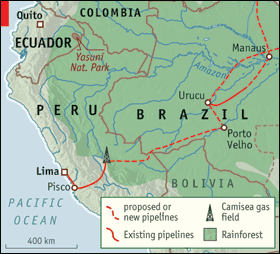Tread softly
Oil and gas extraction does not have to hurt the rainforest, or its people
August 28, 2008 - The Economist
ON THE face of it, a mostly peaceful protest by several thousand tribespeople in Peru's Amazon jungle this month was a resounding victory for those who shook placards and spears. On August 22nd Peru's Congress repealed two presidential decrees, approved in May and June, that made it easier for companies and individuals to buy land belonging to indigenous peoples by reducing the necessary consent from a two-thirds vote by an entire community to that of half the attendees at a mass meeting. The protesters, who occupied oil installations, claimed that many of them would lose their land unwittingly.

Alan García, Peru's unpopular president, argues that do-gooding NGOs are blocking his country's drive for economic development. The protest, and the repeal of the decrees, was an embarrassing setback for the government. Other decrees regulating oil exploration will now be reviewed by an all-party committee.
The issues raised by the dispute are complex--and they apply across much of the Amazon basin. In Peru, as elsewhere in Latin America, the state owns the subsoil, and any oil, gas or minerals it contains. Since 2005 the proportion of Peru's rainforest earmarked for oil and gas exploration has expanded from 15% to 72%. But Indians have title to much of the land above: 58 of the 64 oil blocks on the map of Peru overlap Indian land, of which 17 overlay existing or proposed reserves for people living in voluntary isolation.
Peru plans to award 22 more oil blocks, many in the jungle, next month. Colombia will soon do the same in its southern jungle. Hugo Chávez, Venezuela's president, has championed an impractical plan to pump his country's natural gas across the Amazon rainforest to Buenos Aires. Venezuela's state oil company is helping a newly revived Bolivian state firm explore rainforest. Ecuador has found oil in the Yasuní national park. The government of Rafael Correa has promised Indian tribes not to exploit this--if rich countries pay it $350m a year over the next decade (half the field's estimated revenue). Germany and Italy expressed interest, but the latter seems to have been put off by the deal's fuzziness.
In the past oil companies often adopted a nonchalant approach to the environment. They informed local people before drilling and pumping on their land, rather than gaining their prior consent. A more careful approach is needed to reconcile national interests with those of the inhabitants of the rainforest.
Such a reconciliation is not impossible. Oil and gas extraction has the potential, at least, to bring wealth with less impact on the rainforest and its natives than cattle ranching, soya farming or most forms of logging. Some NGOs are encouraging oilmen to look at the jungle as they would the ocean, sending workers and kit by helicopter--not newly carved road--and sucking out oil and gas from fewer rigs. This is possible, thanks to a technique known as extended-reach drilling. This involves drilling a well down and then horizontally underground for up to 12km. New rigs planted in untouched forest can be 20km apart, says Bill Powers, an engineer and consultant for green groups.
Some oil companies are sceptical. In a 2005 report, Pluspetrol, an Argentine firm, concluded that extended-reach drilling could not work at its Camisea gasfield in southern Peru without causing underground rock to crack and without installing stronger pumps. Steve Suellentrop, the boss in Peru of Hunt Oil, a Texan firm working with Pluspetrol, says that it is operating "at the physical limits of what can be done technologically". It employs "directional drilling" over shorter distances.
Mr Powers, for one, thinks more could be done to reduce environmental impact. Shell, which discovered the Camisea field in the 1980s, once moved a rig, pumps and workers' camp behind a hill at the request of an Indian village, says Murray Jones, who worked there for Shell when the rig was moved. Shell's workers then drilled back to their original starting point, 1.5km away. Mr Jones, who is now a consultant, thinks that this sort of arm's-reach extraction may be cheaper than planting more metallic towers among the trees.
Exploratory work can be done better, too. Instead of bulldozers, many companies nowadays employ machete-wielding labourers to hand-cut pathways for seismic surveys. More use of aerial imaging can reduce the dynamited area. Oil companies are more likely to inject waste water and toxic residues back into the ground than let them spill into jungle rivers, after two lawsuits, one against Texaco (now part of Chevron) for its operations in Ecuador in the 1980s and another against Occidental Petroleum.
Campaigners are strangely reluctant to target state-owned oil firms. That is odd since their environmental record is often worse than that of private companies. But not always: greens praise the Urucu gas project in the Brazilian Amazon run by Petrobras, Brazil's partly state-owned oil company (see article). Petrobras is building a pipeline that will eventually reach Manaus. The parts come by chopper or river and the builders, two-thirds of whom are locals, sleep on boats. There are almost no roads, which averts much of the illegal logging, disease and destitution that often follows forest development. Similar standards would surely make Peru's indigenous peoples more content.